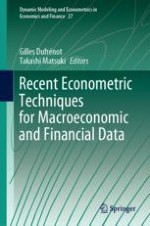2021 | OriginalPaper | Chapter
Detecting Tranquil and Bubble Periods in Housing Markets: A Review and Application of Statistical Methods
Author : Jun Nagayasu
Published in: Recent Econometric Techniques for Macroeconomic and Financial Data
Publisher: Springer International Publishing
Activate our intelligent search to find suitable subject content or patents.
Select sections of text to find matching patents with Artificial Intelligence. powered by
Select sections of text to find additional relevant content using AI-assisted search. powered by
